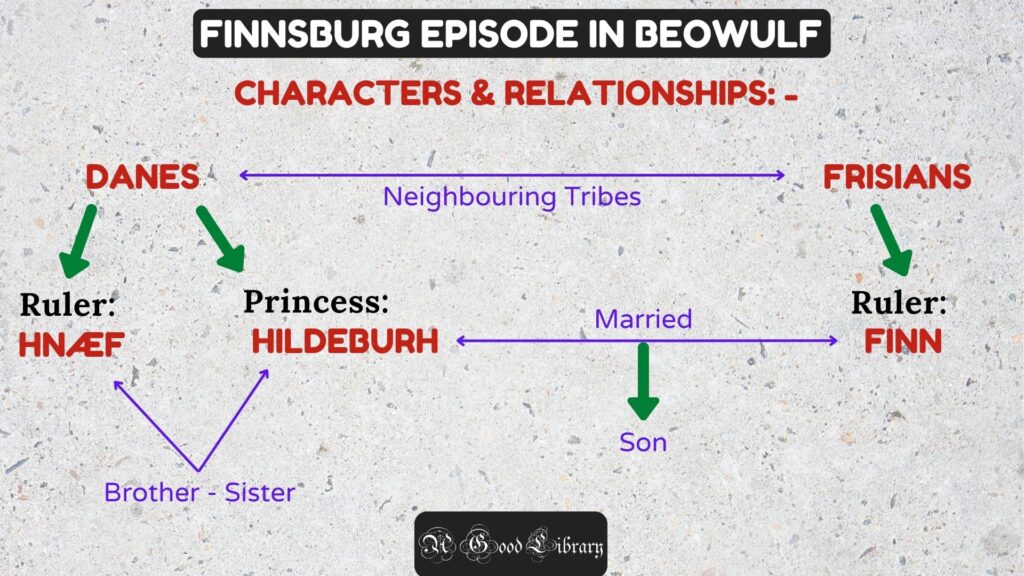| This article is a part of our FREE CRASH COURSE on OLD ENGLISH LITERATURE. CLICK HERE to access the complete material. |
- The Fight of Finnsburh
- The Battle of Finnsburh
- The Finnsburh Fragment
- Finnesburg Fragment
- The Fight at Finnsburg
- Fight at Finnsburg
- Battle of Finnsburg
Use whichever name you like from the above list – it is the same poem. The study of Old English Literature is fascinating in a way. We take bits & pieces of different works and try to build a complete story out of it – like a jigsaw puzzle. Today, we will look at yet another interesting Old English Poem – The Fight at Finnsburh (Yes, we will be using that name today!)
What is ‘The Fight at Finnsburh’?
The Fight at Finnsburh is a name given to a 48-line fragment that is believed to have belonged to a larger Old English / Anglo-Saxon work. The Fight at Finnsburh begin and end midsentence. It talks about the fight where Hnaef & his 60 retailers try to hold off the attackers at the Finnsfort. The story in The Fight at Finnsburh appears to be a version of the heroic tale Hrothgar’s court poet tells in the celebration of Beowulf’s victory over Grendel in Beowulf.
The Fight at Finnsburh is important for literary studies, no doubt. But it is also a great tale! We are reading a story told by someone who lived thousands of years ago. How can that not be fascinating? Let’s begin then…
| CONTENTS OF THIS ARTICLE: – Prerequisite and Context: The Fight at Finnsburh and Beowulf – What is Finnsburg Episode in Beowulf? (Finn Episode) – The Brief Summary of Finn’s Episode in Beowulf – The Connection Between The Fight at Finnsburh and Beowulf Introduction to The Fight at Finnsburh – Who wrote the poem ‘The Fight at Finnsburh‘? – Who translated the poem The Fight at Finnsburh first? – Where did we find the original parchments of the poem The Fight at Finnsburh? – Where can I find the original text of the poem The Fight of Finnsburh? Where are the original fragments preserved? Summary and Analysis of the Old English poem The Fight at Finnsburh – The Translation of The Fight at Finnsburh – The Setting of The Fight at Finnsburh – Summary: – The Story told in The Fight at Finnsburh – The Characters in The Fight at Finnsburh The Fight at Finnsburh and Waldere: Is there any connection between the poems? Takeaway |
Prerequisite and Context: The Fight at Finnsburh and Beowulf
As you are reading about the Fight at Finnsburh, it looks like Old English Literature has fascinated you just as much as it did me. So, it’s safe to assume you might have also read about Beowulf. If yes, Awesome! Here is why –
What is Finnsburg Episode in Beowulf? (Finn Episode)
In Beowulf, the segment (lines 1062 – 1159) discusses a conflict. That segment is called the “Finn Episode.”
The Finn Episode poem starts from line 1079 and goes till 1157 in Seamus Heaney’s translation.
In Beowulf, king Hrothgar hosts a banquet in Beowulf’s honor. King’s scop sings “Finn Episode.” (They called their poets “Scop.”)
“They sang then and played to please the hero,
words and music for their warrior prince,
.
.
.
Over sea-lanes then
back to Daneland
the warrior troop
bore that lady home.”
– Seamus Heaney’s translation of Beowulf
Let’s discuss the story told by Finnsburg Fragment in Beowulf.
The Brief Summary of Finn’s Episode in Beowulf: –

Events as per Finn’s Fragment in Beowulf happen in the following manner: –
- Danes and Frisians are neighboring tribes.
- Danish ruler – Hnaef (Hnæf) [Hocing, Half-Dane, and Scylding]
- Frisian ruler – Finn
- Hnaef’s Sister, Danish princess – Hildeburh
- (Danish) Hildeburh is married to (Frisian) Finn.
- Finn is apparently the brother-in-law of Beowulf.
- Danes visit Frisia. Frisians attack the Danes.
- Danes lose. Hnaef gets killed.
- Frisians win. The son of Finn-Hildeburh gets killed.
- Grief-stricken Hildeburh makes the corpses of her son and her brother, Hnaef, burn on the same bier.
- Homesick Danes have to spend the winter with Frisians.
- When the spring begins, the Danes rise against the Frisians. Kill Finn and become victorious.
- The widow Hildeburh goes back to Denmark with the Danes.
This is just an overview of Finn’s Episode. I’ll discuss it in detail when we study Beowulf.
The Connection Between The Fight at Finnsburh and Beowulf
The crossover between The Fight at Finnsburh and Beowulf is little but significant indeed.
| The Fight at Finnsburh | Beowulf |
| The Fight at Finnsburh discusses the point where Frisians attack Danes when Danes come to visit Frisia. | Beowulf deals with the aftermath of that battle between the Danes and the Frisians. |
NOTE: – The reason behind this attack is unknown.
But, from the context of Beowulf, it becomes easier to reconstruct the story from the bits and parts of The Fight of Finnsburh.
Introduction to The Fight at Finnsburh
The Fight at Finnsburh is an Old English heroic poem about a battle between two rival kings, Hnaef and Hengest.
Who wrote the poem ‘The Fight at Finnsburh’?
Since the original text to which The Fight at Finnsburh belongs is lost with time, the author remains unknown.
Old English literature, including The Fight at Finnsburh, was passed down orally for generations before being written down. As a result, the identity of the original author or authors is often lost to history. The Fight at Finnsburh is an important piece of Anglo-Saxon literature and has been studied by scholars for centuries. It is believed to be a part of a larger work known as the “Finnesburh Fragment,” which consists of three poems that tell the story of the battle at Finnsburh.
Who translated the poem The Fight at Finnsburh first?
It is unknown who first translated The Fight at Finnsburh into modern English.
Old English, the language in which the poem is written, is no longer spoken as a first language and can be difficult for modern readers to understand. As a result, translations of Old English literature, including The Fight at Finnsburh, have been produced over the years to make the works more accessible to a wider audience.
There have been many different translations of The Fight at Finnsburh into modern English, and it is unknown who produced the first one.
Where did we find the original parchments of the poem The Fight at Finnsburh?
Dr. George Hicks discovered the original parchment pieces on which The Fight at Finnsburh was written in the library of Lambelk Palace. The text was found to be drawn over the wooden cover of a book of homilies (sermons/preachings).
Where can I find the original text of the poem The Fight of Finnsburh? Where are the original fragments preserved?
Click here to check out the original Old English text of the poem The Fight at Finnsburh.
The original text of The Fight at Finnsburh can be found in the Anglo-Saxon Chronicle, a collection of Old English annals that document the history of England from the 9th to the 12th century. The Anglo-Saxon Chronicle is preserved in several manuscripts held in various libraries and archives worldwide.
One of the most well-known manuscripts of the Anglo-Saxon Chronicle is the “Parker Chronicle,” which is held at the Parker Library at Corpus Christi College, Cambridge University in the United Kingdom. This manuscript contains the “Finnesburh Fragment” and is considered one of the most important sources for studying Anglo-Saxon literature and history.
Another important manuscript of the Anglo-Saxon Chronicle is the “Laud Chronicle,” which is held at the Bodleian Library at the University of Oxford in the United Kingdom. This manuscript also contains the “Finnesburh Fragment” and is considered to be one of the best copies of the chronicle.
There are several other manuscripts of the Anglo-Saxon Chronicle that are held in libraries and archives around the world, including the British Library in London, the National Library of Scotland in Edinburgh, and the National Archives in Washington, D.C. These manuscripts contain the original text of The Fight at Finnsburh and the other poems in the “Finnesburh Fragment.”
Summary and Analysis of the Old English poem The Fight at Finnsburh
The Translation of The Fight at Finnsburh
Translation by Kevin Crossley-Holland
….. ‘the gables are not burning.’
Then the king, a novice in battle, said:
‘This is not dawn from the east, no dragon
flies here, the gables of the hall are not burning,
but men are making an attack. Birds of battle screech,
the grey wolf howls, spears rattle,
shield answers shaft. The wandering moon gleams
under the clouds; evil deeds will now
be done, bringing grief to this people.
But rouse yourself now, my warriors!
Grasp your shields, steel yourselves,
fight at the front and be brave!’
Then many a thegn, laden in gold, buckled his sword-belt.
Then the stout warriors, Sigeferth and Eaha,
went to one door and unsheathed their swords;
Ordlaf and Guthlaf went to guard the other,
and Hengest himself followed in their footsteps.
When he saw this, Guthere said to Garulf
that he would be unwise to go to the hall doors
in the first rush, risking his precious life,
for fearless Sigeferth was set upon his death.
But that daring man drowned the other voices
and demanded openly who held the door.
‘I am Sigeferth, a prince of the Secgan
and a well-known warrior; I’ve braved many trials,
tough combats. Even now it is decreed
for you what you can expect of me here.’
Then the din of battle broke out in the hall;
the hollow shield called for men’s hands,
helmets burst; the hall floor boomed.
Then Garulf, son of Guthlaf, gave his life
in the fight, first of all the warriors
living in that land, and many heroes fell around him,
the corpses of brave men. The raven wheeled,
dusky, dark brown. The gleaming swords so shone
it seemed as if all Finnesburh were in flames.
I have never heard of sixty warriors
who bore themselves more bravely in the fight
and never did retainers better repay
glowing mead than those men repaid Hnæf.
They fought for five days and not one of the followers
fell, but they held the doors firmly.
Then Guthere withdrew, a wounded man;
he said that his armour was almost useless,
his corselet broken, his helmet burst open.
The guardian of those people asked him at once
how well the warriors had survived their wounds
or which of the young men …..
The Setting of The Fight at Finnsburh
| The Place setting of The Fight at Finnsburh: – | Finnsburuh (Finn’s stronghold), Frisia, Northwestern Europe. (As mentioned in line 36) |
| The time setting of The Fight at Finnsburh: – | Migration-Age Frisia, Early 5th century, c. AD 400 to 800. |

Summary: The Story told in The Fight at Finnsburh
The Fight at Finnsburh is an Old English poem that tells the story of a battle between two rival kings, Hnaef and Hengest, at the fortress of Finnsburh. The poem is believed to be part of a larger work known as the “Finnesburh Fragment,” which consists of three poems that tell the story of the battle.
According to the poem, Hnaef is the king of the Danes, and Hengest is the king of the Jutes. The two kings and their armies engage in a fierce battle at Finnsburh. The hall is destroyed, and many warriors are slain on both sides. Despite the valiant efforts of the warriors, Hnaef is ultimately killed, and Hengest emerges as the victor. He becomes the ruler of the land, and the Danes are left to mourn their defeat.
The poem is relatively brief and does not provide much detail about the motivations of the warriors or the events leading up to the battle. It is primarily focused on describing the violence and destruction of the battle itself. The poem has been studied by scholars for centuries and is an important piece of Anglo-Saxon literature.
The Characters in The Fight at Finnsburh
List of Characters in The Fight at Finnsburh: –
| Character | Description |
| Hnæf | Jutish/ Danish Prince, Hildeburh’s Brother |
| Finn | Ruler of Frisians, Husband to Hildeburh |
| Hengest | One of the 60 warriors of Hnæf who accompany him to visit Hildeburh |
| Sigeferth | A warrior, a prince of the Secgan |
| Eaha | A warrior |
| Ordlaf | A warrior |
| Guthere | A warrior |
| Garulf | son of Guthlaf |
The characters in The Fight at Finnsburh are Hnaef and Hengest, rival kings, and their respective armies. Since the fragment found is incomplete, the poem is relatively brief and does not provide much detail about the individual warriors or their motivations for fighting. However, it is possible to infer certain things about the characters based on their actions and the events described in the poem.
Hnaef: –
Hnaef is the king of the Danes and is described as a noble warrior. He leads his army into battle against Hengest and the Jutes at the fortress of Finnsburh. Despite the ferocity of the battle, Hnaef fights bravely and is described as a formidable opponent. However, he is ultimately killed in the battle, and his death marks the end of the fighting.
Hengest: –
Hengest is the king of the Jutes and is described as a skilled warrior. He leads his army into battle against Hnaef and the Danes at Finnsburh. Hengest emerges as the victor in the battle and becomes the ruler of the land. It is unclear what motivates Hengest to fight against Hnaef, but it is possible that he is motivated by a desire for power and control.
The armies of Hnaef and Hengest are described as being composed of noble warriors who fight bravely in battle. The poem does not provide much detail about the individual warriors, but it is clear that they are skilled in battle and are willing to risk their lives in the fight. The battle is described as being fierce and destructive, and many warriors are killed on both sides.
Overall, the characters in The Fight at Finnsburh are depicted as skilled and brave warriors who are willing to risk their lives in battle. The poem does not delve deeply into the motivations or personalities of the characters, but it does present them as important figures in the story of the battle at Finnsburh.
The Fight at Finnsburh and Waldere: Is there any connection between the two poems?
There is no direct connection between the Old English poems Waldere and The Fight at Finnsburh. Waldere is a heroic poem about Waldere, a warrior who fights against the Franks and their king, Chilperic. The poem is based on the historical figure Walther of Aquitaine, who was a prominent warrior in the 7th century. Waldere is a long and complex poem that is divided into two parts: the first part tells the story of Waldere’s youth and his early battles, while the second part tells the story of his final, epic battle against the Franks.
The Fight at Finnsburh, on the other hand, is a short poem that tells the story of a battle between two rival kings, Hnaef and Hengest, at the fortress of Finnsburh. The poem is believed to be part of a larger work known as the “Finnesburh Fragment,” which consists of three poems that tell the story of the battle. There is no mention of Waldere or the Franks in The Fight at Finnsburh, and the two poems do not have any direct connection to each other. They are simply two works of Old English literature written at different times and deal with different themes and subjects.
Once we discuss the poem Widsith, we will also see the connection between The Fight at Finnsburh and Widsith.
Takeaway
In conclusion, The Fight at Finnsburh is a poem about the battle between Spear-Danes and Scyld Scefing. It is a significant piece of Anglo-Saxon literature that reflects the values and beliefs of the culture during that time. The poem highlights the importance of bravery and strength in Anglo-Saxon society, as well as the power of leadership and the role of kings in defending their people. It also showcases the skill of the Anglo-Saxon poets in using language and imagery to bring the story to life. Overall, The Fight at Finnsburh is a valuable cultural and literary work that continues to be studied and admired to this day.


